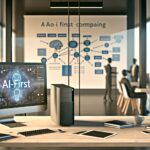Generative AI: Unleashing Creativity and Transforming Industries
As we approach 2025, the realm of artificial intelligence (AI) is rapidly evolving, and generative AI stands at the forefront of this technological revolution. This cutting-edge technology is poised to reshape industries, redefine content creation, and unlock new realms of possibility. In this article, we delve into the transformative power of generative AI and explore its potential impact across various sectors.
The Rise of Personalized Content
One of the most significant applications of generative AI lies in content creation and marketing. By 2025, businesses will harness the power of AI to craft personalized content tailored to individual customers’ preferences and behaviors. This level of personalization will enhance customer engagement and drive sales, as consumers are presented with content that resonates with their unique interests and needs.
Advanced AI-powered tools will refine audience targeting and optimize ad performance, creating immersive advertising experiences that include virtual and augmented reality. For instance, imagine being transported into a virtual world where advertisements seamlessly blend with your surroundings, offering a truly captivating experience. These innovations will not only captivate consumers but also provide businesses with invaluable insights into consumer behavior, allowing them to adjust their strategies in real time.
Moreover, the ability to analyze vast datasets will enable companies to predict trends and preferences, ensuring that the content they deliver is not only relevant but also timely. This predictive capability can revolutionize marketing campaigns, making them more efficient and effective in reaching the right audience.
Revolutionizing Healthcare and Finance
The impact of generative AI extends far beyond content creation and marketing. In the healthcare sector, AI will play a pivotal role in diagnostics, personalized treatment plans, and even surgical procedures. By analyzing vast amounts of medical data, AI algorithms will assist healthcare professionals in making informed decisions, leading to improved patient outcomes and more efficient healthcare delivery.
For example, AI-driven diagnostic tools can analyze medical imaging with remarkable accuracy, helping doctors detect conditions such as tumors or fractures earlier than traditional methods. Furthermore, AI can contribute to personalized treatment plans by analyzing genetic information and patient history, ensuring that each patient receives care tailored to their specific needs.
Similarly, the financial industry will benefit greatly from the integration of generative AI. Advanced algorithms and predictive analytics will enhance fraud detection, risk management, and investment analysis. Sophisticated AI systems will provide personalized financial advice tailored to individual investors’ goals and risk profiles, empowering them to make more informed decisions.
Additionally, generative AI can help financial institutions automate routine tasks, such as data entry and compliance checks, freeing up human resources for more complex decision-making processes. By streamlining operations, companies can reduce costs and improve overall efficiency.
Ethical Considerations: Fairness, Privacy, and Accountability
As generative AI becomes more widespread, ethical concerns surrounding bias, fairness, privacy, and accountability will grow in importance. Ensuring fairness in AI systems and protecting user privacy will be paramount. To address these concerns, there might be an increasing focus on interactive and collaborative generative AI systems that allow humans and machines to collaborate in real-time, fostering responsible AI practices.
For instance, AI systems used in sensitive sectors like healthcare or finance must be thoroughly tested for potential biases, ensuring that decisions are made fairly and without discrimination. This involves not only the algorithms themselves but also the data used to train them. Transparency in AI decision-making processes will be essential to build trust among users and stakeholders.
Moreover, as AI becomes more integrated into everyday life, the potential for misuse or abuse of personal data increases. Robust data privacy measures, including encryption and user consent protocols, will be crucial in protecting individuals’ rights. Establishing clear guidelines for accountability will help mitigate risks associated with the deployment of AI technologies.
Technological Advancements and Market Growth
The generative AI market is experiencing exponential growth, projected to reach $4.5 billion by 2023 and expected to maintain a robust growth rate with a Compound Annual Growth Rate (CAGR) exceeding 20% from 2020 to 2025. This growth is fueled by advancements in machine learning algorithms and the development of complex generative AI systems that push the boundaries of what’s possible, leading to new applications and opportunities.
As the technology matures, we can expect to see increased investment in research and development, leading to breakthroughs that further enhance the capabilities of generative AI. Companies are likely to explore innovative ways to integrate AI into their existing operations, resulting in new business models and revenue streams.
Additionally, the rise of cloud computing and improved computational power will facilitate the deployment of generative AI tools across various industries. As more organizations recognize the value of AI-driven solutions, the market for generative AI will continue to expand, attracting new players and fostering healthy competition.
Democratization and Accessibility
Generative AI tools and platforms are becoming increasingly accessible to a wider audience, including startups and small businesses. User-friendly interfaces and cloud-based solutions are paving the way for widespread adoption across various industries. This democratization of AI technology empowers individuals and organizations to leverage the power of generative AI, fostering innovation and driving progress.
For example, small businesses can now utilize AI-generated marketing content without the need for extensive technical expertise. This accessibility not only levels the playing field but also encourages creativity and experimentation, as more people have the opportunity to create and innovate using AI tools.
Furthermore, educational institutions are beginning to incorporate generative AI into their curricula, equipping the next generation of professionals with the skills needed to thrive in an AI-driven world. By fostering a culture of learning and experimentation, we can ensure that the benefits of generative AI are shared across society.
Hybrid and Multi-Modal Models
Future developments in generative AI may focus on creating hybrid or multi-modal models capable of generating various types of content simultaneously. Imagine a system that can generate text, images, and even audio or video based on a single prompt. These multi-modal models will unlock new possibilities for content creation, enabling seamless integration of different media formats and enhancing the overall user experience.
For instance, a multi-modal AI could generate a marketing campaign that includes written content, visuals, and promotional videos, all tailored to a specific audience. This holistic approach to content creation can lead to more cohesive and impactful messaging, ultimately driving better engagement and conversion rates.
Moreover, as these models become more sophisticated, we can expect them to learn from user interactions, continually refining their output based on feedback. This adaptability will make generative AI an invaluable tool for businesses looking to stay ahead in an ever-evolving marketplace.
Edge Computing and On-Device Models
As generative AI continues to evolve, there might be a shift towards deploying models on edge devices and integrating on-device AI capabilities. This approach will enable real-time tasks such as image editing, language translation, and personalized recommendations without relying solely on cloud-based infrastructure. On-device models will enhance performance, reduce latency, and improve privacy by keeping data processing localized.
For example, imagine a smartphone equipped with generative AI that can recognize your preferences and suggest personalized content or features without needing an internet connection. This localized processing not only improves user experience but also addresses privacy concerns by minimizing data transfer to external servers.
Additionally, edge computing can empower industries such as manufacturing and logistics, where real-time decision-making is crucial. By leveraging on-device AI, companies can optimize their operations, reduce downtime, and improve overall efficiency.
Regulatory Frameworks and Industry Standards
With the widespread adoption of generative AI, there might be the establishment of regulatory frameworks and industry standards to oversee its development, deployment, and usage. These guidelines will address critical issues such as data privacy, model transparency, and accountability, ensuring that generative AI systems are developed and utilized in an ethical and responsible manner.
For instance, regulatory bodies may introduce standards for data handling practices, requiring companies to implement robust security measures to protect user information. Additionally, transparency initiatives could mandate that organizations disclose how AI models are trained and the data sources used, fostering trust among consumers.
As generative AI continues to impact various sectors, collaboration between industry stakeholders, policymakers, and researchers will be essential in shaping a responsible and ethical AI landscape. By working together, we can ensure that the benefits of generative AI are realized while minimizing potential risks.
As we approach 2025, generative AI stands poised to revolutionize industries like healthcare, finance, marketing, and entertainment. While the potential benefits are vast, it is crucial to address ethical considerations and foster responsible AI practices. By embracing this transformative technology while upholding ethical principles, we can unlock a future where creativity flourishes, innovation thrives, and the boundaries of what’s possible are continuously pushed. However, it is essential to approach generative AI with a balanced perspective, acknowledging both its advantages and potential risks, to ensure its responsible and beneficial development and deployment.
Sources:
This article is generated help of SafeComs AI, Automation Bot. to do that.
.





Leave a Reply